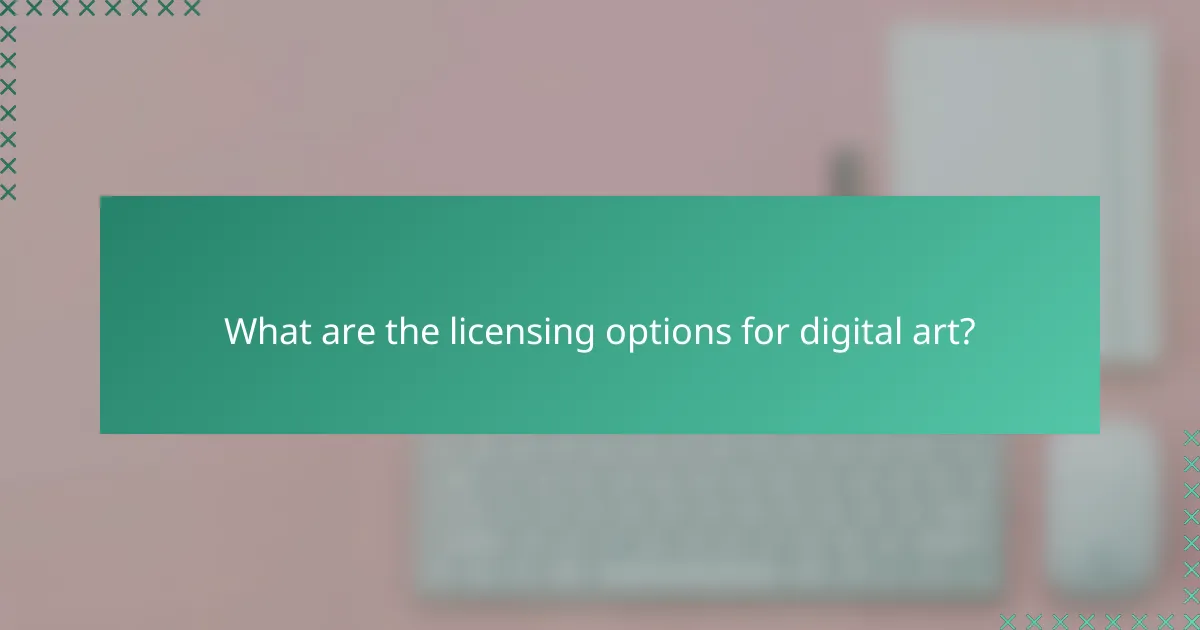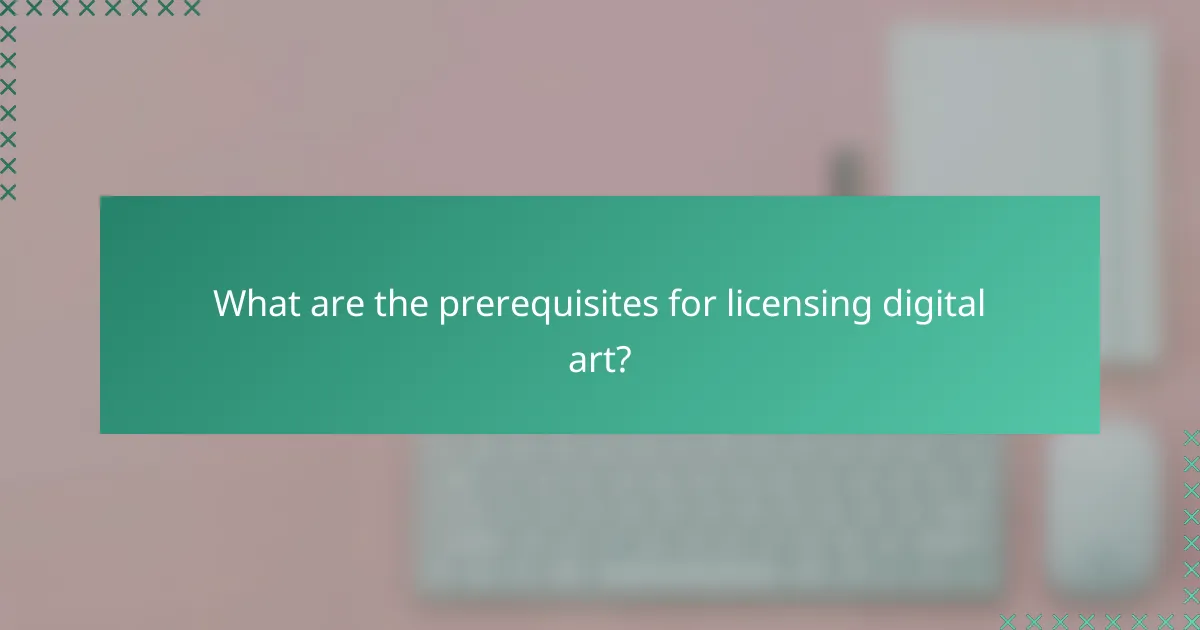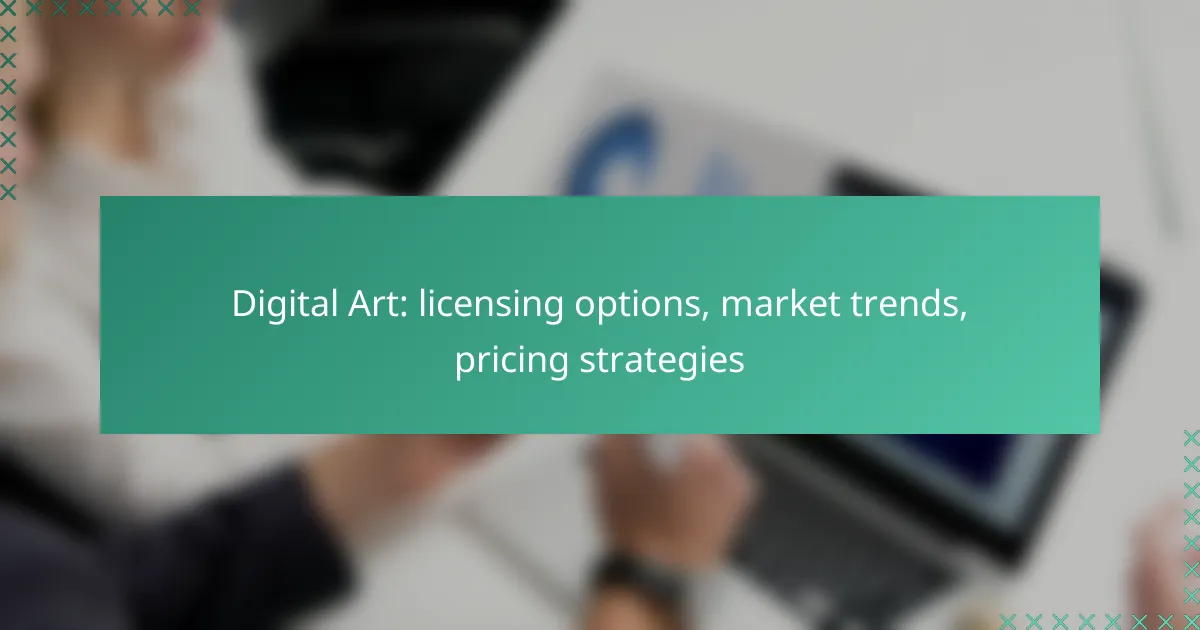In the evolving landscape of digital art, understanding licensing options is essential for artists to protect their work and maximize earnings. The market in 2023 is witnessing rapid growth, fueled by trends such as the rise of NFTs and AI-generated art. Additionally, implementing effective pricing strategies can greatly enhance sales and profitability, allowing artists to navigate this dynamic environment successfully.

What are the licensing options for digital art?
Digital art licensing options vary widely, allowing artists to choose how their work can be used and distributed. Understanding these options is crucial for maximizing revenue and protecting intellectual property.
Exclusive licensing
Exclusive licensing grants a single buyer the sole rights to use the digital artwork, preventing the artist from selling it to anyone else. This option is often more expensive, reflecting the value of exclusivity. Artists should consider the potential for higher earnings against the risk of limiting future sales.
When negotiating exclusive licenses, it’s essential to clearly define the scope of use, duration, and territory. For instance, an exclusive license for a specific campaign may be priced differently than one for perpetual use.
Non-exclusive licensing
Non-exclusive licensing allows multiple buyers to use the same digital artwork. This option typically results in lower prices for buyers, making it more accessible while enabling artists to earn from multiple sales. Artists can benefit from a steady income stream without sacrificing the ability to sell the same piece repeatedly.
When offering non-exclusive licenses, artists should outline the usage rights and any limitations, such as the number of reproductions or specific applications. This clarity helps avoid disputes and ensures fair usage.
Royalty-free licensing
Royalty-free licensing permits buyers to use the artwork without paying ongoing royalties, usually after a one-time fee. This model is popular for stock images and allows for broad usage across various projects. However, artists may earn less per sale compared to exclusive or rights-managed licenses.
It’s important for artists to specify the terms of royalty-free licenses, including any restrictions on resale or modification. This helps maintain control over how their work is utilized while providing buyers with flexibility.
Rights-managed licensing
Rights-managed licensing involves a more complex agreement where the buyer pays based on specific usage parameters, such as duration, distribution, and media type. This can lead to higher fees, making it suitable for high-profile projects. Artists retain more control over their work and can negotiate terms that reflect its value.
Artists should be prepared to provide detailed information about their artwork and its potential uses when entering rights-managed agreements. Clear communication can enhance trust and lead to better deals.
Creative Commons licensing
Creative Commons licensing offers a flexible way for artists to share their work while retaining certain rights. Artists can choose from various licenses that allow for different levels of use, such as attribution, non-commercial use, or share-alike conditions. This approach can help artists gain exposure and build a following.
When selecting a Creative Commons license, artists should carefully consider their goals and the implications of each option. For example, a license that allows commercial use may lead to more visibility but could also dilute the perceived value of the artwork.

How is the digital art market trending in 2023?
The digital art market in 2023 is characterized by significant growth driven by technological advancements and changing consumer preferences. Key trends include the increased demand for NFTs, the expansion of online marketplaces, a shift towards sustainable practices, and the rise of AI-generated art.
Increased demand for NFTs
The demand for non-fungible tokens (NFTs) continues to surge as collectors and investors seek unique digital assets. Artists are leveraging NFTs to sell their work directly to consumers, often at higher price points than traditional digital art. This trend has created new revenue streams and opportunities for creators.
When considering NFTs, artists should be aware of the various platforms available, such as OpenSea and Rarible, and the associated fees, which can vary widely. It’s essential to research the market to understand pricing strategies and potential earnings.
Growth in online marketplaces
Online marketplaces for digital art are expanding rapidly, providing artists with broader access to global audiences. Platforms like Etsy, Saatchi Art, and ArtStation allow creators to showcase and sell their work easily, often with user-friendly interfaces and marketing tools.
Artists should evaluate the commission structures and audience demographics of these platforms to choose the best fit for their work. Diversifying across multiple marketplaces can also enhance visibility and sales potential.
Shift towards sustainable practices
As environmental concerns grow, many digital artists are adopting sustainable practices in their work and business models. This includes using eco-friendly platforms for selling art and minimizing energy consumption associated with digital transactions.
Artists can appeal to environmentally conscious consumers by highlighting their sustainable practices in marketing efforts. Collaborating with organizations focused on sustainability can also enhance credibility and reach.
Emergence of AI-generated art
AI-generated art is gaining traction, with artists using algorithms and machine learning to create innovative pieces. This technology allows for unique styles and concepts that may not be possible through traditional methods.
While AI can enhance creativity, artists should consider the implications of copyright and ownership when using AI tools. Understanding the legal landscape surrounding AI-generated content is crucial to avoid potential pitfalls.

What are effective pricing strategies for digital art?
Effective pricing strategies for digital art can significantly influence sales and profitability. Artists should consider various approaches, including cost-plus, value-based, market penetration, and dynamic pricing, to find the best fit for their work and target audience.
Cost-plus pricing
Cost-plus pricing involves calculating the total cost of creating a piece of digital art and adding a markup for profit. This method ensures that all expenses, including software, hardware, and time, are covered. For example, if an artist spends $100 on tools and 10 hours of work at a rate of $20 per hour, the total cost would be $300, and adding a 20% markup would set the price at $360.
While straightforward, this approach may not always reflect the market value of the artwork. Artists should regularly review their costs and adjust prices accordingly to remain competitive.
Value-based pricing
Value-based pricing sets prices based on the perceived value of the artwork to the customer rather than the cost to produce it. This strategy requires understanding the target audience and what they are willing to pay. For instance, a unique digital piece that resonates deeply with collectors may command a higher price than a more generic work.
To implement this strategy, artists can gather feedback from potential buyers and analyze similar artworks in the market. This approach can lead to higher profit margins if executed correctly, but it requires ongoing market research and customer engagement.
Market penetration pricing
Market penetration pricing involves setting a low initial price to attract buyers and gain market share quickly. This strategy is particularly useful for new artists looking to establish a presence in a competitive market. For example, pricing a digital artwork at $50 instead of $100 can entice more customers and encourage word-of-mouth promotion.
However, artists should be cautious with this approach, as it may undervalue their work and make it difficult to raise prices later. A clear plan for transitioning to higher prices after gaining traction is essential.
Dynamic pricing strategies
Dynamic pricing strategies adjust prices based on real-time market demand, competition, and other factors. This approach can be particularly effective in online marketplaces where prices can fluctuate frequently. For instance, an artist might lower prices during a slow sales period or increase them during high demand.
Implementing dynamic pricing requires careful monitoring of market trends and competitor pricing. Artists should utilize analytics tools to track sales data and adjust their pricing strategies accordingly, ensuring they remain competitive while maximizing revenue.

What are the prerequisites for licensing digital art?
Licensing digital art requires a solid understanding of copyright laws, the ability to identify your target audience, and clear communication of terms. These elements ensure that artists can protect their work while effectively reaching potential buyers.
Understanding copyright laws
Copyright laws protect the rights of artists by granting them exclusive control over their creations. In most countries, digital art is automatically copyrighted upon creation, but registering the work can provide additional legal benefits. Familiarize yourself with local regulations, as they can vary significantly between jurisdictions.
When licensing digital art, consider the different types of licenses available, such as exclusive, non-exclusive, and rights-managed licenses. Each type offers varying levels of control and compensation, so choose one that aligns with your goals and the intended use of your artwork.
Identifying target audience
Knowing your target audience is crucial for effective licensing of digital art. Determine who is most likely to purchase your work, such as businesses, individuals, or specific industries like gaming or advertising. Tailoring your marketing efforts to this audience can enhance your chances of successful sales.
Conduct market research to understand the preferences and purchasing behaviors of your target demographic. Utilize social media platforms and online art marketplaces to gather insights and engage with potential buyers, ensuring that your licensing strategies resonate with their needs and interests.

How do digital art platforms compare?
Digital art platforms vary significantly in terms of features, audience reach, and monetization options. Understanding these differences is crucial for artists looking to maximize their exposure and sales.
Licensing options
Licensing options on digital art platforms can range from exclusive to non-exclusive agreements. Exclusive licenses grant the buyer sole rights to the artwork, while non-exclusive licenses allow the artist to sell the same piece to multiple buyers. Artists should consider their goals and the potential income when choosing a licensing model.
For example, platforms like Adobe Stock offer non-exclusive licensing, which can lead to higher volume sales, whereas sites like ArtStation may facilitate exclusive deals that provide higher upfront payments. It’s essential to read the terms carefully to understand how each platform handles licensing.
Market trends
Current market trends show a growing interest in NFTs and digital collectibles, which are reshaping how digital art is sold and valued. Artists are increasingly leveraging blockchain technology to authenticate their work, creating new revenue streams and engaging with collectors in novel ways.
Additionally, social media integration is becoming vital for marketing digital art. Platforms that allow artists to showcase their work and connect with audiences, like Instagram and TikTok, are essential for driving traffic to sales platforms. Staying updated on these trends can help artists strategically position their work.
Pricing strategies
Pricing strategies for digital art can vary widely based on the platform and the artist’s experience. A common approach is to research similar works to gauge market rates, which can range from a few dollars for small pieces to thousands for high-profile works.
Artists should also consider their target audience and the perceived value of their work. Offering tiered pricing, such as lower prices for prints and higher for original digital files, can attract a broader range of buyers. Regularly reassessing pricing based on demand and market trends is crucial for sustained success.
